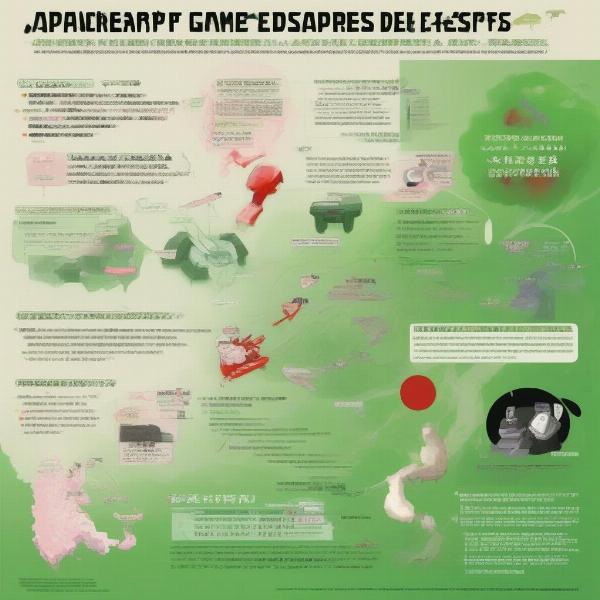The question of why gore is banned in video games in Japan is more nuanced than a simple yes or no answer. While not strictly “banned,” depictions of excessive gore in video games face significant regulations that impact their release and distribution within the country. This article delves into the history, legal framework, and cultural context surrounding this complex issue.
Understanding the CERO Rating System
Japan’s video game rating system, the Computer Entertainment Rating Organization (CERO), plays a crucial role in determining what level of violence is acceptable in games sold domestically. CERO assigns ratings ranging from “A” (all ages) to “Z” (18+). While CERO doesn’t explicitly ban gore, games depicting extreme violence often receive a “D” (17+) or “Z” rating, limiting their market reach. Developers often choose to modify their games for the Japanese market to avoid these stricter ratings.
The Legal Landscape Surrounding Gore in Games
Unlike some countries with specific laws prohibiting the sale of violent video games, Japan relies more on industry self-regulation and the CERO system. However, Article 175 of the Penal Code concerning “indecent displays” can be interpreted to cover excessively graphic content. This ambiguity creates a gray area that developers must navigate carefully, often choosing to err on the side of caution.
How Developers Adapt to Japanese Regulations
Faced with these regulations, developers employ several strategies to release their games in Japan. These include altering the color of blood, reducing the detail of violent scenes, or even removing entire sequences altogether. Some developers create separate versions of their games specifically for the Japanese market.
Cultural Context and Societal Influences
Japan has a complex relationship with violence in media. While samurai films and other forms of entertainment often depict stylized violence, there’s a sensitivity surrounding realistic and gratuitous gore. This cultural nuance influences how game developers approach the depiction of violence in games intended for a Japanese audience.
The Impact of Past Controversies
Several past controversies surrounding violent video games have contributed to the current regulatory landscape. These events heightened public awareness and fueled debates about the impact of violent content on players, leading to increased scrutiny from regulators and the public.
 CERO Ratings and Japanese Video Game Censorship
CERO Ratings and Japanese Video Game Censorship
The Role of Public Perception
Public perception plays a significant role in how game violence is treated in Japan. While there are passionate gamers who enjoy mature titles, a significant portion of the public remains sensitive to graphic violence. This societal attitude influences the decisions of both developers and regulators.
The Difference Between Violence and Gore
It’s important to distinguish between violence and gore. Many games sold in Japan contain violence, but the level of graphic detail is often toned down to avoid excessive gore. This distinction allows developers to create engaging games without crossing the line of what is considered acceptable.
The Future of Gore in Japanese Video Games
The gaming landscape is constantly evolving, and the regulations surrounding violence in games are likely to adapt as well. The ongoing dialogue between developers, regulators, and the public will shape the future of how gore is depicted in video games in Japan.
 Japanese Game Developers Adapting to Censorship
Japanese Game Developers Adapting to Censorship
Frequently Asked Questions about Gore in Japanese Video Games
- Why do some games have different versions in Japan? To comply with CERO ratings and cultural sensitivities regarding graphic violence.
- Is it illegal to sell violent video games in Japan? Not explicitly, but regulations and cultural norms discourage excessive gore.
- What is the CERO rating system? Japan’s age rating system for video games, similar to the ESRB in North America.
- How does public opinion influence game censorship? Public sensitivity to graphic violence influences both developers and regulators.
- Will Japanese censorship laws change in the future? The regulatory landscape is constantly evolving, and changes are possible.
- Are all violent games censored in Japan? No, but excessive gore is often modified or removed.
- What is the difference between violence and gore in Japanese games? Violence is often allowed, but gratuitous gore is restricted.
Conclusion
Understanding why gore is banned in video games in Japan requires a deeper look into the interplay between regulations, cultural context, and societal values. While not a complete ban, the restrictions on graphic violence significantly impact the development and release of games in the Japanese market. The ongoing conversation about violence in media will continue to shape the future of how games are created and consumed in Japan. Share your thoughts on this topic in the comments below!

